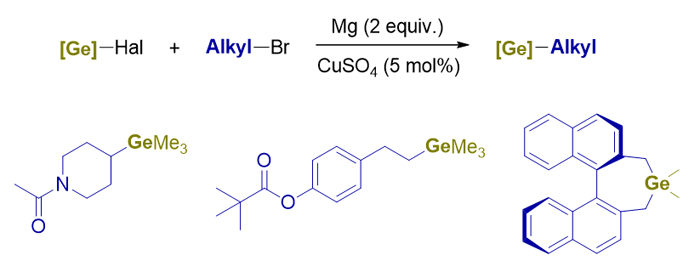| [1] |
Glockling, F. Gmelin Handbook of Inorganic Chemistry Ge Organogermanium Compounds Part 2: Ge(CH3)3R and Ge(C2H5)3R Compounds, Springer-Verlag, Berlin, Heidelberg, 1988, pp. 1-295.
|
| [2] |
Xue, W.; Mao, W.; Zhang, L.; Oestreich, M. Angew. Chem. Int. Ed. 2019, 58, 6440.
doi: 10.1002/anie.201901860
|
| [3] |
(a) Keess, S.; Oestreich, M. Org. Lett. 2017, 19, 1898.
doi: 10.1021/acs.orglett.7b00672
pmid: 32483965
|
|
(b) Meißner, G.; Kretschmar, K.; Braun, T.; Kemnitz, E. Angew. Chem. Int. Ed. 2017, 56, 16338.
doi: 10.1002/anie.201707759
pmid: 32483965
|
|
(c) de la Vega-Hernández, K.; Romain, E.; Coffinet, A.; Bijouard, K.; Gontard, G.; Chemla, F.; Ferreira, F.; Jackowski, O.; Perez-Luna, A. J. Am. Chem. Soc. 2018, 140, 17632.
doi: 10.1021/jacs.8b09851
pmid: 32483965
|
|
(d) Debrauwer, V.; Turlik, A.; Rummler, L.; Prescimone, A.; Blanchard, N.; Houk, K. N.; Bizet, V. J. Am. Chem. Soc. 2020, 142, 11153.
doi: 10.1021/jacs.0c03556
pmid: 32483965
|
|
(e) Queen, A. E.; Selmani, A.; Schoenebeck, F. Org. Lett. 2022, 24, 406.
doi: 10.1021/acs.orglett.1c04088
pmid: 32483965
|
| [4] |
Su, P. F.; Wang, K.; Peng, X.; Pang, X.; Guo, P.; Shu, X. Z. Angew. Chem. Int. Ed. 2021, 60, 26571.
doi: 10.1002/anie.202112876
|
| [5] |
For Ni catalyzed reductive coupling reactions, see: (a) Gua, J.; Wan, g, X.; Xue, W.; Gong, H. Org. Chem. Front. 2015, 2, 1411.
doi: 10.1039/C5QO00224A
pmid: 32905517
|
|
(b) Poremba, K. E.; Dibrell, S. E.; Reisman, S. E. ACS Catal. 2020, 10, 8237.
doi: 10.1021/acscatal.0c01842
pmid: 32905517
|
|
(c) Zhang, L.; Oestreich, M. Angew. Chem. Int. Ed. 2021, 60, 18587.
doi: 10.1002/anie.202107492
pmid: 32905517
|
|
(d) Duan, J.; Wang, K.; Xu, G.-L.; Kang, S.; Qi, L.; Liu, X.-Y.; Shu, X.-Z. Angew. Chem. Int. Ed. 2020, 59, 23083.
doi: 10.1002/anie.202010737
pmid: 32905517
|
|
(e) Cheng, L.; Zhou, Q.-L. Acta Chim. Sinica 2020, 78, 1017. (in Chinese)
doi: 10.6023/A20070335
pmid: 32905517
|
|
(程磊, 周其林, 化学学报, 2020, 78, 1017.)
doi: 10.6023/A20070335
pmid: 32905517
|
|
(f) Li, Y.-Q.; Fan, Y.-H.; Jia, Q.-F. Chin. J. Org. Chem. 2019, 39, 350. (in Chinese)
doi: 10.6023/cjoc201806038
pmid: 32905517
|
|
(李娅琼, 范玉航, 贾乾发, 有机化学, 2019, 39, 350.)
doi: 10.6023/cjoc201806038
pmid: 32905517
|
| [6] |
During this manuscript is under revision, Shu group reported a nickel catalyzed reductive coupling reaction between Me3GeCl and alkyl bromide using Mn as reductant, see: Guo, P.; Pang, X.; Wang, K.; Su, P.-F.; Pan, Q.-Q.; Han, G.-Y.; Shen, Q.; Zhao, Z.-Z.; Zhang, W.; Shu, X.-Z. Org. Lett. 2022, 24, 1802.
|
| [7] |
doi: 10.1002/anie.202115592
|
| [8] |
Eiji, M.; Kei, M.; Masayuki, I.; Koji, H.; Hideki, Y.; Koichiro, O. Bull. Chem. Soc. Jpn. 2009, 82, 1012.
doi: 10.1246/bcsj.82.1012
|
| [9] |
For Cu catalyzed reductive coupling reaction using Mg as reductant, see: (a) Liu, J.-H.; Yang, C.-T.; Lu, X.-Y.; Zhang, Z.-Q.; Xu, L.; Cui, M.; Lu, X.; Xiao, B.; Fu, Y.; Liu, L.. Chem. Eur. J. 2014, 20, 15334.
doi: 10.1002/chem.201405223
|
|
(b) Maaliki, C.; Thiery, E.; Thibonnet, J. Eur. J. Org. Chem. 2017, 2017, 209.
doi: 10.1002/ejoc.201600540
|
|
(c) Cheng, L.-J.; Mankad, N. P. Chem. Soc. Rev. 2020, 49, 8036.
doi: 10.1039/D0CS00316F
|
|
(d) Han, B.-S.; Shi, Z.; He, H.-H.; Zhang, X.-H. Chin. J. Org. Chem. 2021, 41, 695. (in Chinese)
doi: 10.6023/cjoc202008012
|
|
(韩博士, 时郑, 何慧红, 张兴华, 有机化学, 2021, 41, 695.)
doi: 10.6023/cjoc202008012
|
| [10] |
Yields of the reaction between Et3GeCl and CyBr under the condition with/without CuSO4 are 90% and 84% respectively. The result may be attributed to the relative inertness of Et3GeCl towards reductive dimerization. Considering that alkyl-GeEt3 as radical precursor would lead to the competition between ethyl radical and the target alkyl radical, this manuscript mainly focus on the synthesis of alkyl-GeMe3.
|
| [11] |
Bhatt, S.; Nayak, S. K. Tetrahedron Lett. 2006, 47, 8395.
doi: 10.1016/j.tetlet.2006.09.073
|
| [12] |
We thus checked GC-MS result of the reactions in Table 2 and Me6Ge2 less than 5% was found for almost all substrates.
|
| [13] |
(a) Barrau, J.; Rima, G.; Amine, M. E.; Satgé, J. Synth. React. Inorg. Met.-Org. Chem. 1988, 18, 21.
doi: 10.1080/00945718808060521
pmid: 18345620
|
|
(b) Hölbling, M.; Masters, S. L.; Flock, M.; Baumgartner, J.; Hassler, K.; Robertson, H. E.; Wann, D. A. Inorg. Chem. 2008, 47, 3023.
doi: 10.1021/ic7018764
pmid: 18345620
|
|
(c) Yoder, C. H.; Crouse, J. E.; Wilson, D. A. J. Organomet. Chem. 1984, 276, 9.
doi: 10.1016/0022-328X(84)80599-9
pmid: 18345620
|
